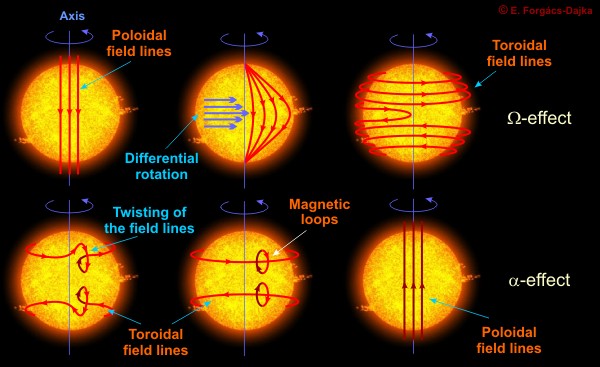The sun's magnetic field changes polarity approximately every 11 years. It happens at the peak of each solar cycle as the sun's inner magnetic dynamo re-organizes itself.
A reversal of the sun's magnetic field is, literally, a big event. The domain of the sun's magnetic influence (also known as the "heliosphere") extends billions of kilometers beyond Pluto. Changes to the field's polarity ripple all the way out to the Voyager probes, on the doorstep of interstellar space.
When solar physicists talk about solar field reversals, their conversation often centers on the "current sheet." The current sheet is a sprawling surface jutting outward from the sun's equator where the sun's slowly rotating magnetic field induces an electrical current. The current itself is small, only one ten-billionth of an amp per square meter (0.0000000001 amps/m2), but there’s a lot of it: the amperage flows through a region 10,000 km thick and billions of kilometers wide. Electrically speaking, the entire heliosphere is organized around this enormous sheet.
During field reversals, the current sheet becomes very wavy.
Cosmic rays are also affected. These are high-energy particles accelerated to nearly light speed by supernova explosions and other violent events in the galaxy.
"The sun's north pole has already changed sign, while the south pole is racing to catch up," Scherrer said. "Soon, however, both poles will be reversed, and the second half of solar max will be underway."
Source: NASA
"The changing magnetic field is described by dynamo models: the rotation takes effect on the convective envelope and the result is the surface differential rotation, when the angular rotation has an equator-to-pole gradient. Differential rotation acts on the primordial poloidal field, and starts to build up a toroidal one (see the figure). Under the surface, somewhere at the bottom of the convective zone, this spin up effect streches, thus reinforces the toroidal field until it becomes an unstable state, when the buoyant force begins to act on them. Thus, the toroidal magnetic field arranged in vast flux tubes begins to emerge and reaches the solar surface. At this time, a typical magnetic feature appears: a magnetic loop, with a cool bipolar spot pair at the footpoints. The large scale meridional convection works just the opposite: somehow (that we do not understand clearly) it regenerates the poloidal field, transporting the emerging flux towards the poles. Finally, this process results in a poloidal field, similar to that we had at the beginning, but the polarity is now the opposite in sign."Source: http://www.konkoly.hu/solstart/stellar_activity.html




No comments:
Post a Comment